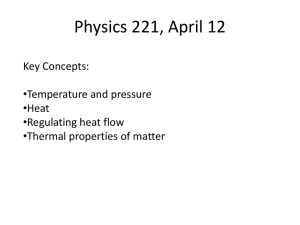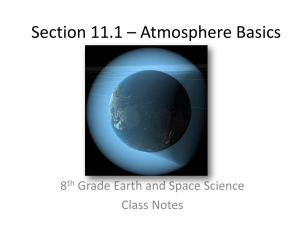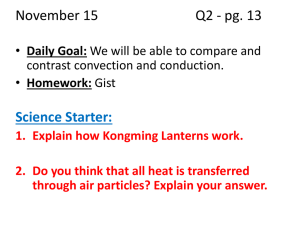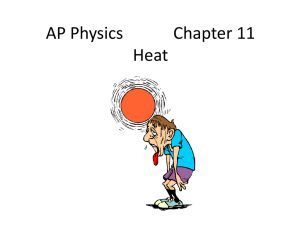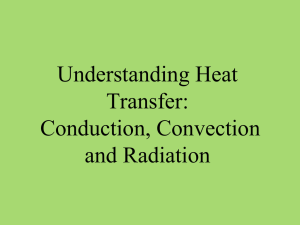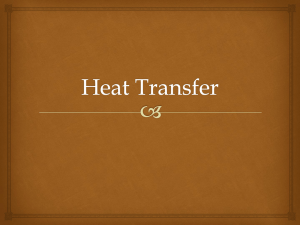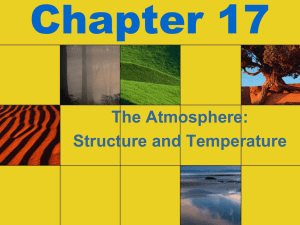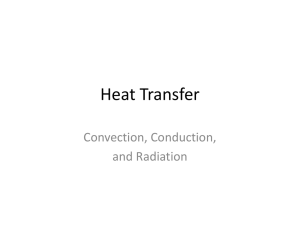What is Thermal Energy Transfer? - Mater Academy Charter Middle
advertisement
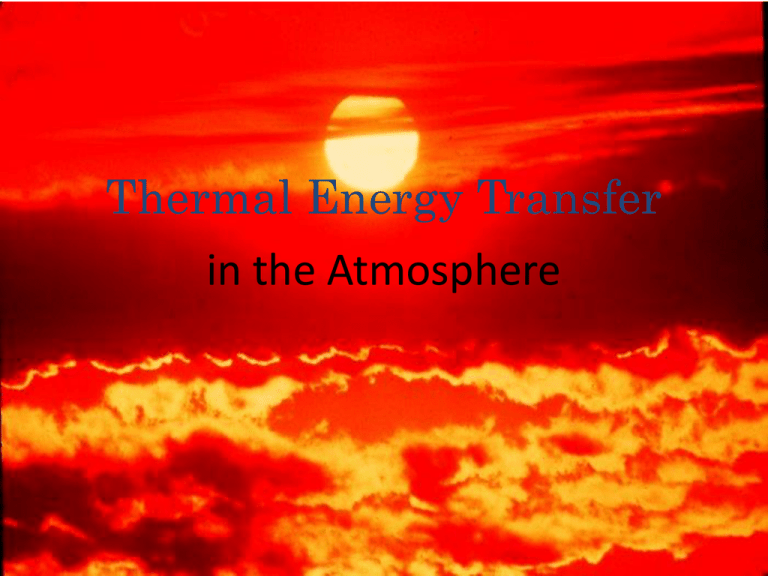
Thermal Energy Transfer in the Atmosphere Temperature and Thermal Energy TEMPERATURE - a measure of the average kinetic energy of the individual particles in an object. Thermal Energy – is the total energy of all of the particles. Temperature is a measure of… • The total amount of energy in an object • The total amount of thermal energy in an object • How much heat something gives off • How fast the molecules in an object are moving Heat is… • Energy given off or absorbed by an object • A measure of the motion of the molecules in an object • The total amount of molecular energy in an object What is Thermal Energy Transfer? • Thermal energy transfer is the movement of heat energy from one substance to another. • Heat (energy) always moves from objects with high temperature to objects with low Cold Hot What is Thermal Energy Transfer? Heat will continue to move until both substances are the same temperature. Warm Warm What is Thermal Energy Transfer? • The greater the difference in temperature between the substances, the faster the heat will transfer. http://www.photoanswers.co.uk/ImgGalleryTn/91/10191/2417_16333.jpg Your Coke becomes cold because the heat from the soda transfers into the ice, not the other way around. No matter what it feels like, cold does not transfer into your body. What is really happening here? Why do you wear heavy clothes when it’s cold outside? http://www.alaska-in-pictures.com/data/media/9/man-in-extreme-cold_355.jpg Examples • You touch a black car in the summer and the heat from the car transfers into your hand. • A breeze makes you feel cooler because the wind transfers heat away from your body What is Thermal Energy Transfer? • There are three types of thermal energy transfer: – Radiation – Conduction – Convection Conduction • The transfer of thermal energy by the collisions between particles of matter. (through direct contact). • Molecules transfer energy to the molecules next to them. Conduction • Conduction – heat transferred by particles colliding into one another, such as in a metal. • Transfer of energy by touch • Not an effective transfer in a gas. • Primarily solids Conduction • The molecules do not have to be the same substance. http://www.theelusivefish.com/articles/wp-content/uploads/2007/09/hot-stove.jpg Transfer of Conduction Energy from Earth's surface to the atmosphere • Conduction describes the transfer of heat (kinetic) energy between two objects in physical contact. Soils are better conductors than water; water is a better conductor than air. Therefore, no significant amount of energy is transferred by conduction from Earth's surface to the atmosphere, only a thin layer of air touching the ground is warmed by conduction, which may however be important for the local weather/climate. Thermal energy is CONDUCTED from the warm ground to the air above it. Convection • Heat transfer by convection is the transfer of thermal energy (heat) through the fluid (liquids and gases) movement of currents. Convection • Convection – heat transferred by the circulation of a fluid (or gas), such as in a heating system at home; important near the surface of the Sun. • Hot air rises cool air falls CONVECTION - heat is transferred by the MOVEMENT of currents within a fluid (a liquid or a gas). http://physics.uoregon.edu/~jimbrau/BrauImNew/Chap07/FG07_03.jpg As air above the road warms up, it becomes less dense and rises and is replaced by cooler air, forming a convection current. Convection • Warm fluids rise, cool down, sink, and then are warmed again. Transfer of Convection Energy from Earth's surface to the atmosphere • Convection (also advection) is the transport of heat as a result of the movement of water being warmed. When water is warmed its atoms move faster and spread apart, reducing its density, i.e. it will rise. One could say “Heat rises” but it's actually the water that is rising. This creates convection currents and stands for the remaining 30% of total heat flux from surface to atmosphere. Convection (together with ocean currents) plays a significant role in transferring heat pole wards and thereby distributing heat over the whole Earth. Air mass advection describes how either cold or warm air masses travel to areas of opposite temperature characteristics. http://www.eeb.ucla.edu/test/faculty/nezlin/Lecture1/Fig0803.jpg The radiator warms the room by warming the air around it. Then the warm air transfers heat to the rest of the room through convection. When water changes from one phase to another, Latent heat is exchanged. Radiation • There is no direct contact between the substances. RADIATION - the transfer of energy by electromagnetic waves. Radiation does NOT require matter to transfer thermal energy. Radiation • Radiation – heat transferred by the flow of electromagnetic radiation, like heat felt from the campfire. • Radiation is the only type of heat transfer that can happen in a vacuum. • Heat transfer through waves Radiant Energy from the sun radiates through empty space to earth. http://stardate.org/images/gallery/sun5.jpg http://www.blog.thesietch.org/wp-content/uploads/2007/04/earth.jpg ENERGY ON EARTH • Not all of the sun’s energy reaches the Earth’s Surface. • 20% of the Sun’s Energy is ABSORBED by gases and particles in the Atmosphere. • Ozone, Oxygen & Water Vapor absorb ultraviolet light • Water and carbon dioxide(CO2) absorb infrared light. • Earth’s Atmosphere (clouds) and the surface of the Earth REFLECTS about 30% of Sun’s radiation • About 50% of the Sun’s radiation is absorbed by the Earth's Surface RADIATION BALANCE Earth’s temperature remains stable because of the balance between the amount of radiation coming from the Sun and the amount going out from Earth. Land, trees, and the oceans absorb and emit solar radiation mainly in the form of infrared radiation. Transfer of Radiation Energy from Earth's surface to the atmosphere • Radiation from Earth's surface to the atmosphere is simply caused by Earth's temperature and is equal to 70% of total heat flux from surface to atmosphere. This thermal radiation does not require a medium, which means that it can travel through a vacuum like space. This is for example how solar energy reaches the earth, and how heat escapes from the earth back into space. (IR) = Infrared radiation Energy Heat Transfer - The atmosphere and Earth's surface, including biosphere, geosphere, hydrosphere and cryosphere, are strongly coupled and exchange, among others, water vapor and heat through evaporation. These processes are part of the hydrological cycle and results in condensation, cloud formation, precipitation and runoff, and supply energy to the weather/climate system. The energy transfer between the earth's surface and the atmosphere is partly based on infrared radiation, but energy is also transferred by conduction, convection, and radiation. THE GREENHOUSE EFFECT Certain gases, such as CO2, in the atmosphere act like the glass in a greenhouse warming the atmosphere. http://www.aos.wisc.edu/~aalopez/aos101/wk5/heatrans.jpg This picture illustrates all three type of heat transfer. Can you identify them all? Conduction Convection Radiation http://www.aos.wisc.edu/~aalopez/aos101/wk5/heatrans.jpg CLASSWORK Draw a picture of how energy is transferred from the sun to the earth and then back to space. Be sure to label Radiation, Conduction and Convection




